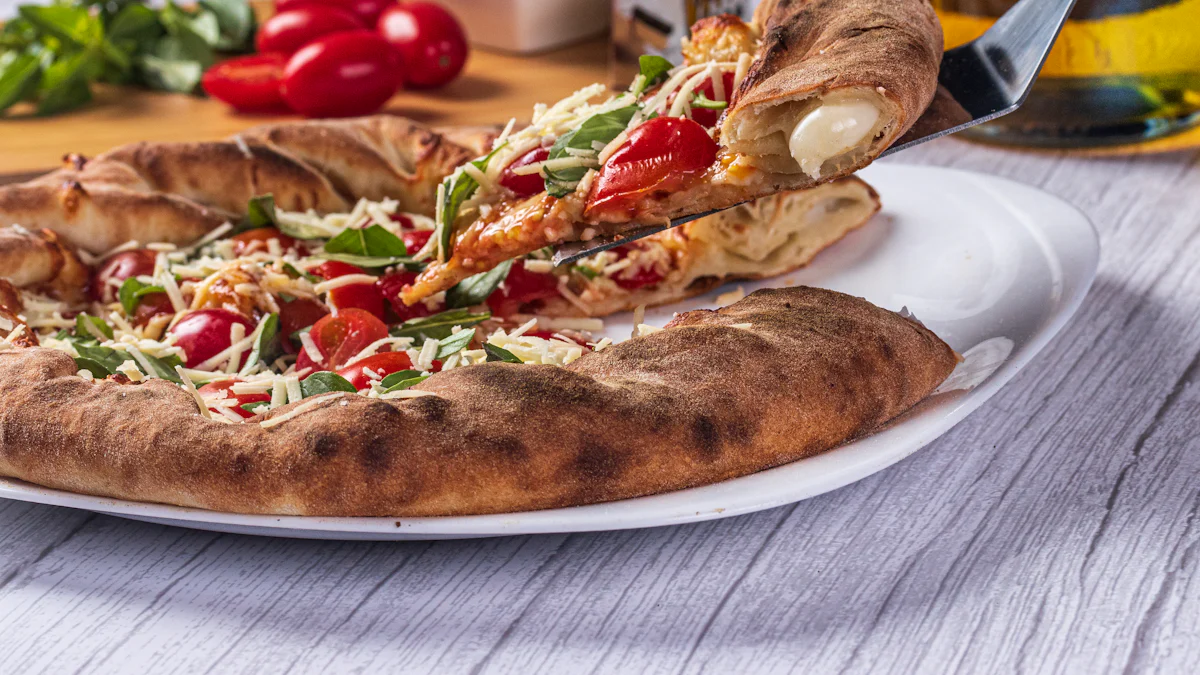
Achieving a crispy pizza crust at home can feel like a daunting task. You might wonder why your homemade pizza doesn't have that perfect crunch you crave. The challenge often lies in balancing the dough's moisture and weight from toppings. But don't worry! Mastering this skill brings immense satisfaction. Imagine biting into a slice with a perfectly browned, crispy bottom crust. With the right techniques and tools, like a pizza cooking stone, you can transform your pizza-making game. Get ready to elevate your homemade pizza to restaurant-quality levels!
Invest in a pizza cooking stone for even heat distribution and moisture absorption, ensuring a crispy crust.
Manage your dough hydration by using a kitchen scale and experimenting with water ratios to achieve a light, airy texture.
Utilize cold fermentation to enhance flavor and extensibility, allowing for a more open and crispy crust.
Preheat your oven to between 475°F and 500°F for optimal baking temperatures that mimic professional pizza ovens.
Choose high-protein flour, like bread flour, to create a strong gluten network that contributes to a crispy texture.
Incorporate a small amount of oil and sugar in your dough to enhance crispiness and promote browning.
Don't hesitate to experiment with different techniques, such as pre-baking your crust, to achieve that perfect crunch.
When it comes to achieving that perfect crispy pizza crust, the right equipment can make all the difference. Let's dive into the essentials you need to elevate your pizza-making game.
A pizza cooking stone is a game-changer for home pizza enthusiasts. This tool mimics the environment of a traditional brick oven, providing even heat distribution and excellent heat retention. When you preheat your pizza cooking stone with the oven, it ensures that your dough hits a hot surface, which is crucial for a crispy crust. The stone absorbs moisture from the dough, preventing sogginess and promoting that delightful crunch.
Here are some tips for using a pizza cooking stone effectively:
Preheat Properly: Always preheat the stone with your oven. This step ensures it's at the right temperature when you place your pizza on it.
Avoid Thermal Shock: Never put a cold stone in a hot oven or expose a hot stone to cold water. This can cause the stone to crack.
Versatility: Besides pizza, you can use the stone for baking bread or even roasting vegetables.
If you don't have a pizza cooking stone, don't worry! There are alternatives that can still help you achieve a crispy crust:
Pizza Steel: Similar to a stone, a pizza steel offers excellent heat retention and can produce a crispy crust. It's durable and less prone to cracking.
Cast Iron Skillet: A well-seasoned cast iron skillet can serve as a great alternative. Preheat it in the oven and then transfer it to the stovetop for a quick finish.
Baking Sheet: While not as effective as a stone or steel, a preheated baking sheet can still help. Flip it upside down for a flat surface and preheat it in the oven.
Choosing the right equipment is the first step in mastering the art of crispy pizza crust. Whether you opt for a pizza cooking stone or one of its alternatives, you'll be well on your way to creating delicious homemade pizzas with that perfect crunch.

Creating a crispy pizza crust starts with perfecting your dough. The dough's texture and flavor play a crucial role in achieving that delightful crunch. Let's explore how you can manage dough hydration and understand the role of fermentation to elevate your pizza-making skills.
Water is a key ingredient in your pizza dough. It helps form gluten, which gives the dough its structure. But did you know that adding more water can actually make your crust crispier? High-hydration doughs create a crust that stays crisp yet moist during cooking. This balance results in beautiful air pockets throughout the crust, enhancing its texture.
Here's how you can manage dough hydration effectively:
Measure Precisely: Use a kitchen scale to measure your ingredients. Precision ensures consistency in your dough's hydration level.
Experiment with Ratios: Start with a hydration level of around 65-70%. Adjust based on your preference and the flour you're using.
Mix Thoroughly: Ensure the water is evenly distributed throughout the dough. This step is crucial for gluten development and achieving the right texture.
Fermentation is where the magic happens. It not only develops flavor but also impacts the dough's texture. A long, cold fermentation allows the dough to relax, making it easier to stretch and shape. This process also enhances the dough's extensibility, leading to a more open, porous internal structure within the crust.
Consider these tips for effective fermentation:
Use Cold Fermentation: Let your dough ferment slowly in the refrigerator. This method leads to better browning and a chewier crust with complex flavors.
Plan Ahead: Allow at least 24 hours for fermentation. The longer the dough ferments, the more flavor it develops.
Monitor Temperature: Keep an eye on the temperature during fermentation. It plays a significant role in the quality of your crust.
By managing dough hydration and understanding the role of fermentation, you set the foundation for a crispy, flavorful pizza crust. These techniques will help you craft a dough that's not only easy to work with but also delivers that satisfying crunch in every bite.

Achieving a crispy pizza crust isn't just about the dough and equipment. The baking temperature plays a crucial role too. Let's explore how you can optimize your oven settings for that perfect crunch.
Preheating your oven is a step you shouldn't skip. It ensures that your pizza cooks evenly and the crust gets that desired crispiness. Here's how you can make the most of preheating:
Set the Right Temperature: Aim for a temperature between 475°F and 500°F. This range helps mimic the high heat of a professional pizza oven.
Allow Enough Time: Give your oven at least 20 minutes to reach the desired temperature. This ensures the entire oven, including the racks, is hot enough.
Use a Thermometer: Ovens can be unpredictable. A thermometer helps you verify that the oven has reached the correct temperature.
High temperatures are key to achieving a crispy crust. They help cook the pizza quickly, preventing the dough from becoming soggy. Here's what you need to know:
Quick Cooking Time: Bake your pizza for about 10 to 15 minutes. This short duration at high heat ensures the crust crisps up while the toppings cook through.
Monitor Closely: Keep an eye on your pizza as it bakes. Every oven is different, and you might need to adjust the time slightly.
Golden Brown Perfection: Look for a golden brown color on the crust. This indicates that it's crispy and ready to enjoy.
By preheating your oven and baking at high temperatures, you set the stage for a deliciously crispy pizza crust. These steps help you achieve that restaurant-quality texture right in your own kitchen.
Choosing the right flour is crucial for achieving that perfect crispy crust. You might wonder why some flours work better than others. The secret lies in the protein content. Flour with at least 12 percent protein helps create a strong gluten network, which is essential for a crispy texture. This gluten network traps air and moisture, allowing the crust to rise and crisp up beautifully.
Here's how you can make the most of your flour choice:
Opt for Bread Flour: Bread flour typically has a higher protein content compared to all-purpose flour. This makes it an excellent choice for a crispy crust.
Experiment with Blends: Try mixing different flours to find your perfect balance. A blend of bread flour and all-purpose flour can offer both structure and tenderness.
Measure Accurately: Use a kitchen scale to ensure precise measurements. This helps maintain consistency in your dough's texture.
Adding oil and sugar to your dough can significantly enhance its crispiness. These ingredients not only contribute to flavor but also affect the crust's texture.
Oil's Role: Brushing a thin layer of olive oil over the pizza base before adding toppings can work wonders. It creates a barrier that prevents moisture from seeping into the dough, ensuring a crispy finish. Olive oil also adds a subtle richness to the crust.
Sugar's Contribution: A small amount of sugar in the dough can promote browning during baking. This results in a golden, crispy crust. Sugar also feeds the yeast, aiding in fermentation and flavor development.
Consider these tips when incorporating oil and sugar:
Use Sparingly: A little goes a long way. Too much oil or sugar can weigh down the dough and affect its rise.
Balance Flavors: Ensure that the added ingredients complement your toppings. For instance, olive oil pairs well with Mediterranean-inspired pizzas.
By using the right flour and incorporating oil and sugar, you can elevate your pizza crust to new levels of crispiness. These simple adjustments can transform your homemade pizza into a delightful culinary experience.
You've now got the tools to create a crispy pizza crust right at home. Remember these key techniques: choose the right equipment, perfect your dough, and optimize your baking temperature. Don't hesitate to experiment with different methods. Try pre-baking your crust for a few minutes on a hot stone. This step can keep your crust crispy even after reheating. Most importantly, enjoy the process. Pizza-making is an art, and every attempt brings you closer to that perfect slice. So, roll up your sleeves and savor the journey!
To get that perfect crispy crust, you need to keep it thin and avoid piling on too many toppings. Bake your pizza at a high temperature. This method ensures the crust cooks quickly and crisps up beautifully.
Using a baking stone can transform your pizza-making experience. Preheat the stone in your oven for at least 20 minutes at the highest temperature it can handle. This step ensures the stone is hot enough to absorb moisture from the dough, resulting in a crispy crust.
Maintaining the crispiness of a thin-crust pizza involves a few tricks. Par-bake the dough before adding toppings. You can also sprinkle some cornmeal on the baking surface. These methods help keep the crust crispy even after adding toppings.
For a perfectly crisp crust, increase your oven's cooking temperature. Set it to the highest setting possible. This high heat helps the crust cook quickly, preventing it from becoming soggy.
Creating a thick, crisp, and chewy crust at home requires following some basic steps. Use a high-protein flour for the dough. Allow the dough to ferment slowly in the refrigerator. This process enhances the texture and flavor, giving you a delightful crust.
Yes, you can use a regular baking sheet. Preheat it in the oven and flip it upside down for a flat surface. While it might not be as effective as a stone, it can still help achieve a crispy crust.
Incorporating a small amount of oil and sugar can enhance the crust's crispiness. Oil creates a barrier against moisture, while sugar aids in browning. Use these ingredients sparingly to avoid weighing down the dough.
Higher dough hydration can lead to a crispier crust. It creates a dough that stays moist yet develops a beautiful crust during baking. Aim for a hydration level of around 65-70% for best results.
Fermentation develops the dough's flavor and texture. A long, cold fermentation allows the dough to relax and become more extensible. This process results in a crust with an open, porous structure that crisps up nicely.
Absolutely! You can still achieve a crispy crust without a stone or steel. Use a preheated cast iron skillet or a baking sheet. These alternatives can help you create a deliciously crispy pizza crust at home.
Contact: Sunny
Phone: +86 13925920757
E-mail: sunny@sy-stones.com
Whatsapp:+86 13925920757
Add: Asia Metal Recycling Resources Park, Longfu Town, Sihui District, Zhaoqing City, Guangdong, PRC
We chat
